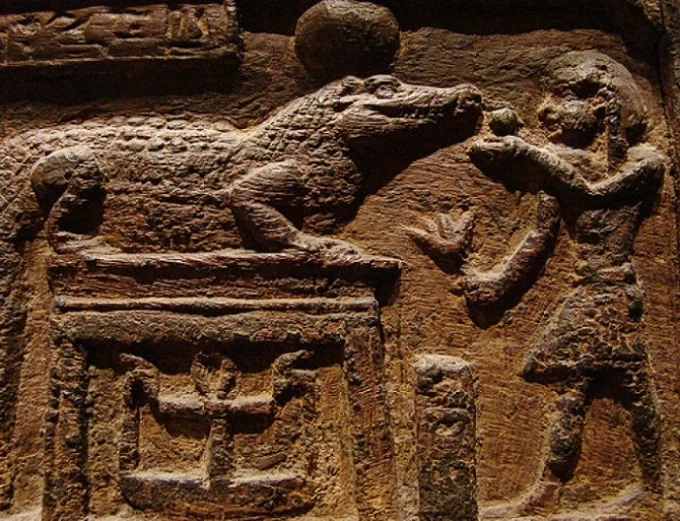Egyptian crocodile god: why they had thousands of crocodiles mummies?

The worship of animals and natural forces is a prevalent aspect of all ancient civilizations, yet certain cults have left a lasting influence on contemporary man. The function of holy animals was allocated to some of the ugliest and terrifying creatures on the globe during the age of the Egyptian pharaohs – sacred crocodiles of Nile.
Sebek, the crocodile deity, king of Nile
The Nile’s importance in the formation of ancient Egyptian civilization cannot be overstated; this river influenced the very survival of the peoples who dwelt along its banks. The Nile, which stretches over 7,000 kilometers from south to north, nourished Egyptians; its floods produced rich harvests in regions next to the river; and the absence of floods condemned many to starvation.
There have been specific constructions, called nilometers, since the time of the pharaohs, whose function was to estimate the level of the river in order to anticipate the following crop.

However, it’s hardly strange that the Egyptians attempted to curry favor with such strong forces by imbuing interactions with the Nile’s permanent inhabitant and, to some degree, master the crocodile with a specific ceremonial aspect. The Egyptians, among other things, predicted the onset of the floods based on the behavior and movement of these creatures.
The deity Sebek (or Sobek), who was represented as a man with a crocodile’s head, is one of Egypt’s most ancient and important gods. He was revered not just as the Nile’s king and flood lord, bestowing fertility and riches, but also as a god who personified time and eternity. With a crocodile’s head and a gorgeous crown, Sebek was represented.
The religion of Sebek was particularly strong at Crocodilopolis, the present city of Faiyum, southwest of Memphis, Egypt’s ancient capital. The Greeks who arrived in this country with Alexander of Macedon in the 4th century BC gave the place the name “Crocodilopolis” or the City of Reptiles. Shedit was the Egyptian name for this city.
Shedit, located near Lake Merida in the oasis of Fayyum, a large valley known throughout ancient Egypt for its fertility, became a location of worship for the deity Sebek and his living embodiments – crocodiles.
Pharaoh Amenemhat III of the twelfth dynasty erected a pyramid for himself near the city of Shedit in the nineteenth century BC. The Labyrinth, a holy edifice that has not remained to this day, was next to the pyramid, as did the temple complex, where Sobek’s son, Petsuhos, dwelt.
According to rules and regulations that are no longer known, the priests used to choose which crocodile would have the honor of becoming the divine offspring. The crocodile resided in the Labyrinth, which included numerous chambers on various levels in addition to the pond and sand – according to ancient sources, particularly Herodotus’ accounts, the number of rooms reputedly reached several thousand. The halls and corridors of the Labyrinth were believed to be 70 thousand square meters in size.

Crocodile’s offerings
Petsuchos was fed meat, bread with honey, and wine by the priests, and those who were killed by the crocodile’s jaws gained divine status; their bodies were embalmed and buried in a hallowed tomb. Drinking water from a pond where such a crocodile dwelt was thought to bring good luck and ensure the deity’s protection.
The “son of Sebek’s” corpse was mummified and buried close after death. Several thousand of these mummies have been unearthed, mostly at the Umm el-Breigat cemetery. The same priests picked a crocodile as the god’s next manifestation.
The information about the crocodile cult in Shedite that has survived to our time is extremely scarce, and it is mostly based on the records of Greek visitors. Strabo, an ancient Greek scholar who visited Egypt in the first century BC, wrote the following notes:
“Our host, one of the authorities in charge of introducing us into the secrets of the place, accompanied us to the lake, bringing with him flatbread, roast pork, and a jug of honeyed wine from his meal. We discovered the crocodile on the lake’s bank. When the priests approached the animal, one opened its mouth and placed the tortilla inside, followed by the meat, and then the honey concoction. The animal then dove into the lake and swam to the other shore. However, when another stranger arrived with an offering of the first fruits, the priests seized the presents from him and went around the lake, locating the crocodile and feeding him the food they had brought in the same manner.”

Crocodilopolis was renamed Arsinoe in honor of the ruler’s wife under Ptolemy II.
Because El-Faiyum is one of Egypt’s least-studied regions by archaeologists, it’s likely that further evidence corroborating or disputing the traditions concerning the Labyrinth of Crocodilopolis could emerge in the near future.
Nonetheless, the crocodile deity Sebek’s religion may be found in other parts of ancient Egypt; for example, at Kom Ombo, a city that used to be known as Nubt, there is a temple devoted to Sebek, which has been available to the public since 2012 to show crocodile mummies from surrounding tombs.




